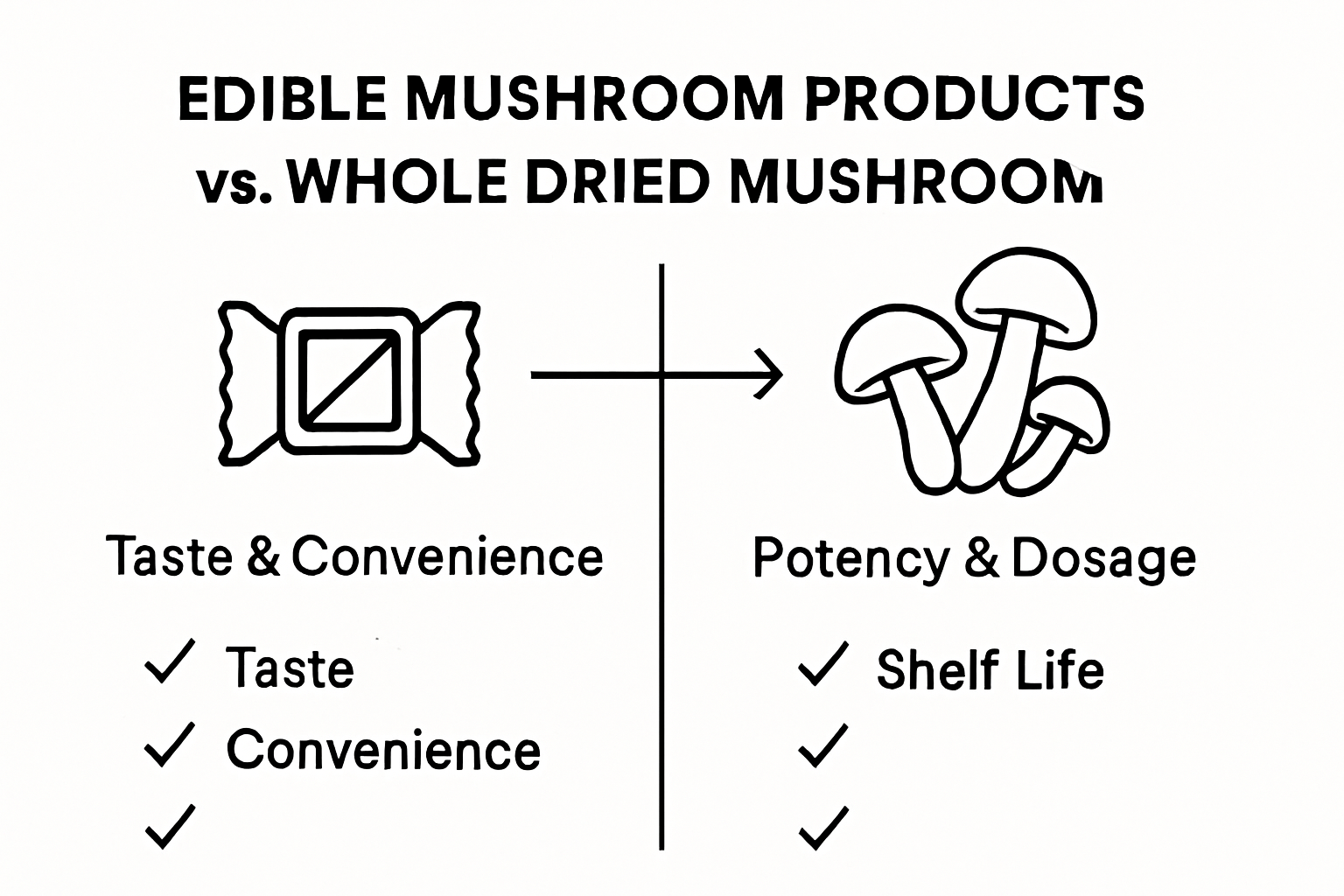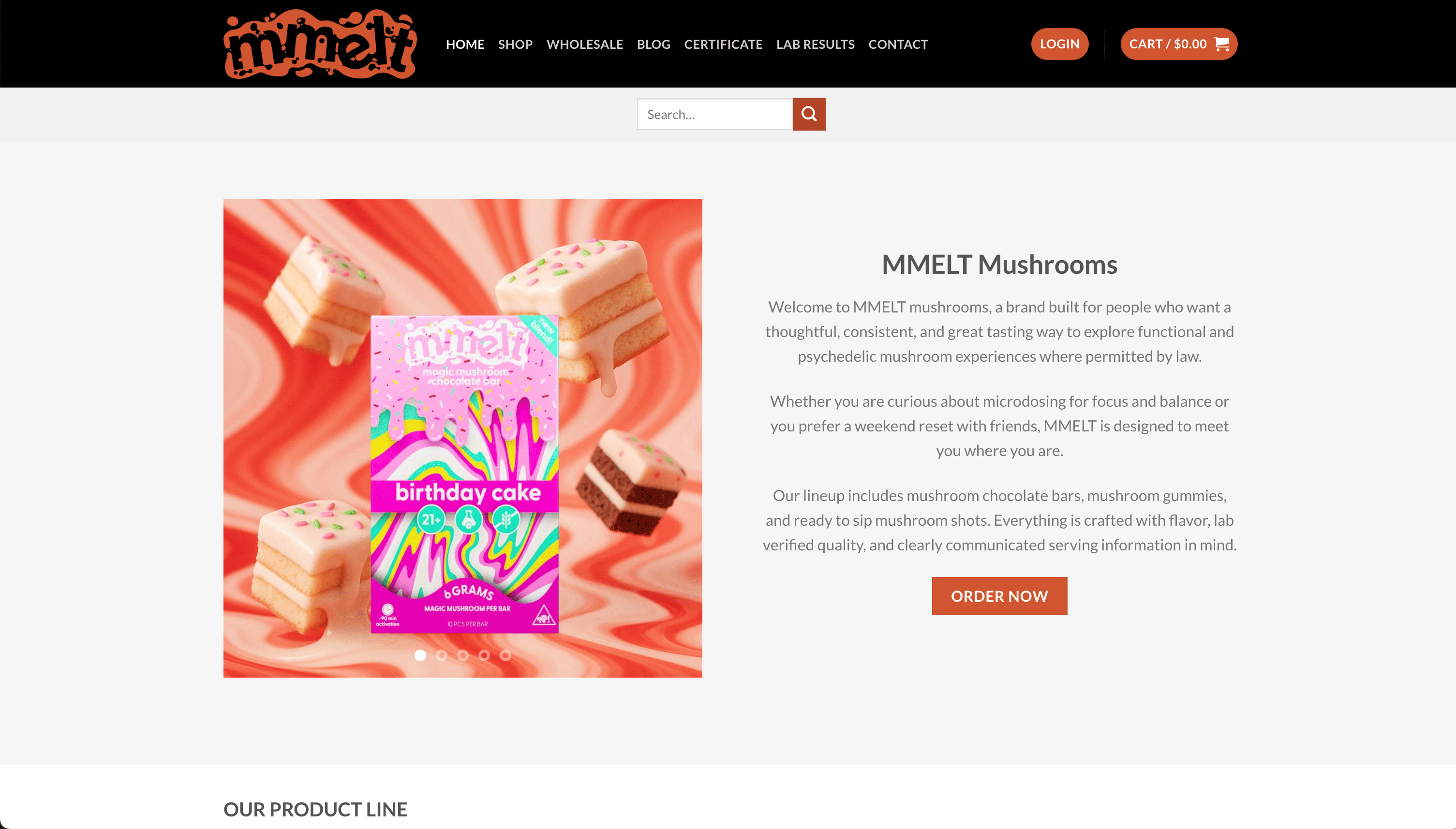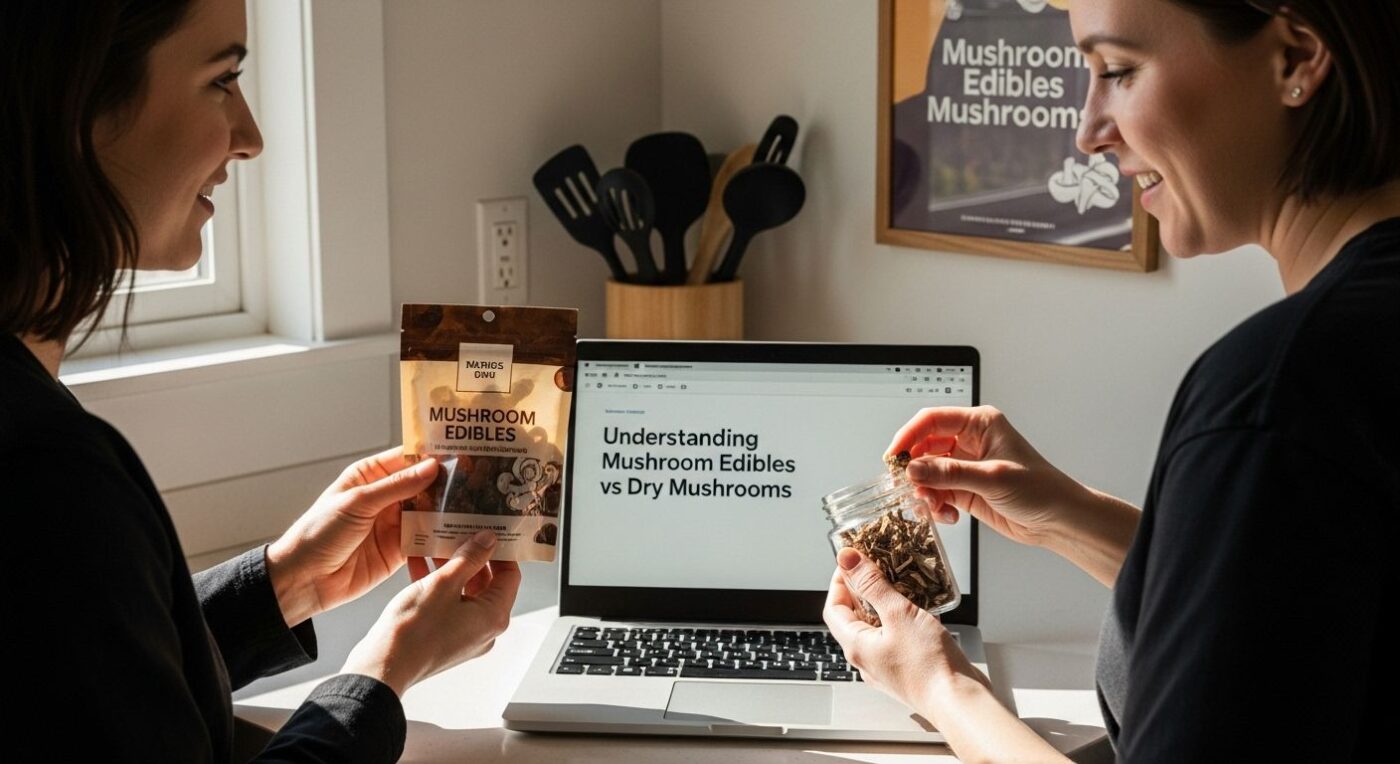Blog
Understanding Mushroom Edibles vs Dry Mushrooms
Mushroom edibles and dry mushrooms are popping up everywhere as people search for new ways to boost wellness and explore natural supplements. You might think dried mushrooms would have the strongest nutrients, but it turns out the way you consume them changes everything. Processing methods can dramatically alter the potency, absorption, and even the precise health effects you get so your choice could impact way more than you expect.
Table of Contents
- Defining Mushroom Edibles And Dry Mushrooms
- Nutritional And Psychoactive Differences
- Health Benefits And Functional Uses
- Consumption Methods And Bioavailability
- Market Trends And Consumer Preferences
Quick Summary
| Takeaway | Explanation |
|---|---|
| Mushroom edibles offer controlled dosing. | Edibles provide precise cannabinoid or psychedelic concentrations for predictable effects, unlike traditional methods. |
| Dry mushrooms retain higher nutraceutical value. | Dehydrated mushrooms preserve essential proteins and bioactive compounds, enhancing nutritional benefits over fresh forms. |
| Edibles create enhanced flavors for easier consumption. | Processed formats like gummies or chocolates improve taste, making it more enjoyable for consumers. |
| Processing affects the bioavailability of compounds. | Different consumption methods significantly influence how effectively active compounds are absorbed by the body. |
| Market demand is shifting towards functional mushroom products. | Consumers increasingly prefer convenient, organic, and scientifically backed mushroom supplements to support health. |
Defining Mushroom Edibles and Dry Mushrooms
Mushroom edibles and dry mushrooms represent two distinct approaches to consuming and preserving functional and psychedelic mushrooms. Understanding their fundamental differences helps consumers make informed choices about consumption methods, potency, storage, and overall experience.
What Are Mushroom Edibles?
Mushroom edibles are processed products infused with mushroom extracts or compounds, designed to provide a more palatable and controlled consumption experience. These products transform raw mushroom materials into convenient formats like gummies, chocolates, and shots. Unlike traditional consumption methods, edibles offer precise dosing, consistent potency, and enhanced flavor profiles.
Key characteristics of mushroom edibles include:
- Precise cannabinoid or psychedelic compound concentration
- Consistent and predictable effects
- Enhanced taste and easier consumption
- Longer shelf life compared to fresh mushrooms
Understanding Dry Mushrooms
Dry mushrooms represent the raw, unprocessed form of mushrooms that have been dehydrated to remove moisture content. According to research published in the Journal of Agricultural and Food Chemistry, drying is a critical preservation technique that extends mushroom shelf life while concentrating their bioactive compounds.
The drying process involves carefully removing water content through methods like hot air drying, convective drying, or freeze drying. These techniques help maintain the mushrooms’ structural integrity, preserve nutritional value, and prevent microbial growth. Dry mushrooms can be stored for extended periods and are typically consumed by grinding, brewing, or rehydrating before use.
While both mushroom edibles and dry mushrooms offer unique benefits, the choice between them depends on individual preferences, desired consumption method, and specific therapeutic or recreational goals.
To clarify the key differences between mushroom edibles and dry mushrooms, the following table compares their main features, benefits, and usage aspects side by side.
| Feature | Mushroom Edibles | Dry Mushrooms |
|---|---|---|
| Form | Processed (gummies, chocolates, shots) | Dehydrated whole or ground mushrooms |
| Dosing | Precise, standardized | Variable, depends on preparation |
| Flavor | Enhanced; more palatable | Earthy; may be bitter or strong |
| Nutritional Content | May lose some nutrients in processing | Higher protein and bioactive compound retention |
| Shelf Life | Longer, due to added preservatives or processing | Extended, from dehydration |
| Convenience | Easy to use; ready-to-eat | Requires grinding, brewing, or rehydration |
| Bioavailability | Often improved, standardized absorption | Can vary based on preparation and user metabolism |

Nutritional and Psychoactive Differences
The nutritional and psychoactive characteristics of mushroom edibles and dry mushrooms present fascinating variations that significantly impact consumer experience and potential therapeutic applications. Understanding these nuanced differences helps individuals make informed choices about consumption methods and expected outcomes.
Nutritional Profile Variations
Mushrooms are remarkable nutritional powerhouses, with their composition dramatically influenced by processing techniques. According to research published in the Journal of Agricultural and Food Chemistry, the drying process concentrates certain nutritional elements while potentially altering others. Dry mushrooms typically retain higher concentrations of proteins and bioactive compounds compared to fresh specimens.
Key nutritional considerations include:
- Protein concentration ranges from 19-35% of dry mass
- Carbohydrate content varies between 50-65% of dry mass
- Preservation of essential minerals like iron, zinc, and phosphorus
- Concentration of dietary fiber and vitamins during dehydration
Psychoactive Compound Dynamics
Psilocybin and psilocin, the primary psychoactive compounds in functional mushrooms, demonstrate complex behavioral interactions depending on consumption format. Processing methods significantly influence molecular stability and absorption rates. Edible formats like mushroom shots provide more controlled dosing mechanisms compared to traditional dry mushroom consumption.
The molecular transformation during processing can impact psychological and physiological responses. Factors such as extraction technique, temperature, and preparation method directly influence the bioavailability of psychoactive compounds. Edibles often provide more predictable experiences due to standardized formulation processes, whereas dry mushrooms may present more variable effects based on individual grinding and preparation techniques.
While both formats offer unique advantages, consumers should approach consumption with an understanding of these intricate nutritional and psychoactive nuances, prioritizing personal wellness and informed decision making.
Health Benefits and Functional Uses
Mushrooms represent an extraordinary category of functional foods with profound health potential, offering diverse benefits through their unique nutritional and bioactive compounds. Understanding their therapeutic applications requires exploring their complex biochemical profiles and potential interactions with human physiological systems.
Immune System Enhancement
Functional mushrooms demonstrate remarkable immunomodulatory capabilities, primarily through their rich polysaccharide content. According to research published in comprehensive nutritional studies, these compounds stimulate immune cell activity and support overall immune system resilience.
Key immune-boosting characteristics include:
- Activation of natural killer cells
- Stimulation of macrophage and T lymphocyte responses
- Production of critical immune signaling molecules
- Enhanced inflammatory response regulation
Metabolic and Cognitive Health Support
Beyond immune functionality, mushrooms offer significant metabolic and neurological benefits. The bioactive compounds found in functional mushrooms interact with human cellular mechanisms, potentially supporting cognitive function and metabolic balance. Mushroom shots and edible formats provide convenient methods for integrating these nutritional powerhouses into daily wellness routines.
Potential therapeutic applications include:
- Blood glucose regulation
- Cholesterol management
- Neuroprotective potential
- Stress response modulation
The complex interactions between mushroom compounds and human physiological systems highlight their potential as holistic wellness supplements.
To showcase the main health-related benefits and functional uses of mushrooms as described in the article, this table summarizes their core wellness applications and physiological effects.
| Health Benefit | Description |
|---|---|
| Immune System Enhancement | Stimulate immune cell activity and support immune defense |
| Metabolic Support | Assist in blood glucose regulation and cholesterol levels |
| Cognitive Health | Offer neuroprotective properties and stress modulation |
| Inflammatory Response Control | Help regulate inflammation via immune signaling |
| While more research is needed to fully understand their comprehensive health impacts, current scientific evidence suggests significant promise in supporting overall human health through natural, plant based interventions. |
Consumption Methods and Bioavailability
The effectiveness of mushroom consumption depends critically on bioavailability, which determines how efficiently the body absorbs and utilizes active compounds. Different consumption methods dramatically influence the absorption, potency, and overall physiological impact of mushroom compounds.
Absorption Mechanisms
Bioavailability represents the proportion of ingested compounds that enter systemic circulation and produce active effects. According to research published in nutritional science journals, processing techniques significantly modulate compound absorption rates and metabolic interactions.
Key factors influencing bioavailability include:
- Molecular structure of active compounds
- Processing and preparation methods
- Individual metabolic variations
- Presence of complementary absorption enhancers
Comparative Consumption Strategies
Dry mushroom consumption involves direct ingestion through grinding, brewing, or rehydration, which can produce variable absorption rates. In contrast, mushroom shots and edible formats offer more standardized and predictable absorption profiles.
Edible formats provide several distinct advantages:
- Precise dosage control
- Enhanced flavor profiles
- Improved compound stability
- Potentially higher initial bioavailability
The intricate relationship between consumption method and biological uptake underscores the importance of thoughtful product selection. Consumers should consider individual metabolic factors, desired outcomes, and product formulation when choosing between dry mushrooms and specialized edible formats.

Market Trends and Consumer Preferences
The mushroom market is experiencing a significant transformation, driven by evolving consumer preferences, increased health consciousness, and innovative product development. Understanding these dynamic market trends provides insights into the expanding landscape of mushroom consumption and product offerings.
Emerging Consumer Motivations
Consumer interest in mushroom products has shifted dramatically, moving beyond traditional culinary applications to embrace functional and therapeutic potential. According to research on consumer behavior, taste, nutritional advantages, and perceived health benefits are primary drivers of mushroom product selection.
Key consumer motivation factors include:
- Growing interest in natural health supplements
- Desire for scientifically backed wellness solutions
- Increased awareness of mushroom’s nutritional profile
- Preference for convenient consumption formats
Product Innovation and Market Dynamics
Modern consumers seek innovative and accessible mushroom products that integrate seamlessly into their wellness routines. Mushroom shots and edible formats represent a significant market response to these evolving preferences, offering convenient, standardized, and palatable consumption methods.
Market transformation characteristics include:
- Rising demand for organic and lab-verified products
- Expansion of functional mushroom product categories
- Increased investment in research and development
- Growing acceptance of mushroom-based supplements
The mushroom market continues to demonstrate remarkable resilience and potential, reflecting a broader shift towards holistic, science-driven approaches to personal health and nutrition.
Precision, Safety, and Enjoyment in Every Mushroom Experience
Struggling to choose between dry mushrooms and edibles? The article highlighted real issues: unpredictable dosing, uncertain potency, and difficulties with taste when using traditional dry mushrooms. At MMELT Mushrooms, you do not have to deal with those frustrations. We provide delicious, lab-verified mushroom-infused edibles like gummies, chocolates, and shots that deliver exact dosing and superb flavors with full transparency and educational support.

Do not guess when your health and your experience matter. Make the switch to safer, enjoyable, and precisely measured mushroom products now. Explore our lab-tested selection by visiting MMELT Mushrooms. Whether you are seeking reliable microdosing or inventive wellness solutions, our detailed product info and trusted results give you control and peace of mind. Act today to transform your approach to functional and psychedelic mushrooms.
Frequently Asked Questions
What are mushroom edibles?
Mushroom edibles are processed products infused with mushroom extracts or compounds, designed for convenient consumption. They come in formats like gummies, chocolates, and shots, offering precise dosing and enhanced taste compared to raw mushrooms.
How do dry mushrooms differ from mushroom edibles?
Dry mushrooms are the unprocessed, dehydrated form of mushrooms, retaining higher concentrations of proteins and bioactive compounds. They require grinding or rehydrating before consumption, unlike mushroom edibles, which provide standardized dosages and greater palatability.
What are the health benefits of consuming mushrooms?
Mushrooms offer various health benefits, including immune system enhancement, metabolic support, and potential cognitive health improvements. Their bioactive compounds stimulate immune cell activity and may regulate blood glucose and cholesterol levels.
How does the bioavailability of compounds differ between dry mushrooms and mushroom edibles?
Bioavailability, the body’s ability to absorb active compounds, varies by consumption method. Mushroom edibles often provide more predictable absorption and precise dosages, while dry mushrooms may lead to variable absorption rates depending on preparation and individual metabolism.

